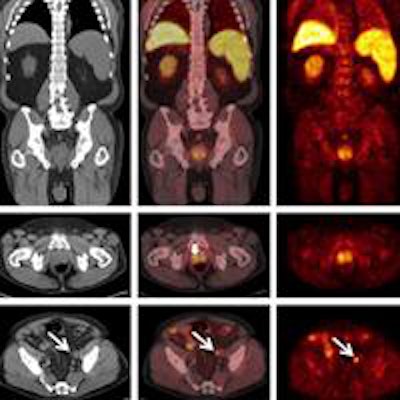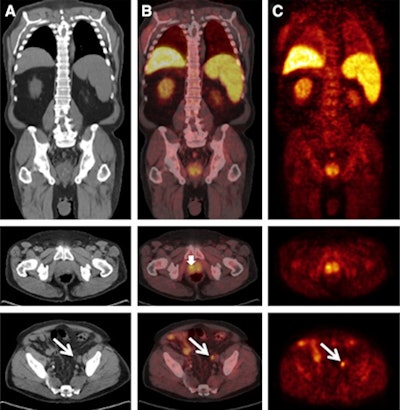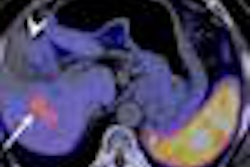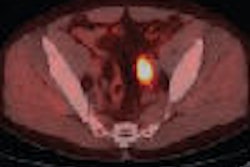
PET/CT with carbon-11 (C-11) acetate is better at detecting lymph-node metastasis among patients planning for or completing radical prostatectomy than conventional imaging, and it can help predict treatment efficacy and survival, according to a study published in the May Journal of Nuclear Medicine.
While PET/CT's positive predictive value (PPV) was relatively low (49%), patients with false-positive PET results had a "significantly worse" prognosis than those with true-negative PET results. The relatively low PPV, the researchers speculated, might be due to inadequate lymph-node dissection or poor pathologic identification of positive nodes.
PET/CT detected lymph-node metastases with a sensitivity of 68% and specificity of 78% among patients with negative CT findings, wrote lead author Dr. Mohammed Haseebuddin, from the division of urologic surgery at Washington University School of Medicine in St. Louis, and colleagues (JNM, May 2013, Vol. 54:5, pp. 699-706).
Metastatic disease
Previous research has found that 40% to 50% of patients in the U.S. with newly diagnosed prostate cancer have intermediate- or high-risk localized disease, according to the authors. In addition, as many as 20% of these patients have metastatic disease, usually in lymph nodes.
Because identification of lymph-node involvement is so important for treatment planning, many individuals typically receive CT or MRI scans. The problem is that both modalities generally can only detect larger metastases. One recent meta-analysis calculated the sensitivity of CT and MRI to be between 39% and 42% for detecting pelvic lymph nodes (Clinical Radiology, April 2008, Vol. 63:4, 387-395).
"Although multiple studies have demonstrated promising results with C-11 acetate PET for diagnosing local and distant disease after initial treatment failure, less is known about its value for initial prostate cancer staging," the authors wrote.
In this study, a PET/CT scan (Biograph Duo or Biograph 40, Siemens Healthcare) was performed on 107 men with intermediate- or high-risk localized prostate cancer and negative conventional imaging findings. They received an injection of C-11 acetate, ranging from 1.48 GBq to 0.74 GBq in dose, depending on the scanner used. Approximately 10 to 15 minutes after administration, a 10- to 20-sec CT scan was obtained from the skull base through the pelvis.
Five men were scanned for lymph-node staging only, while the other 102 individuals underwent lymph-node staging and prostatectomy. The patients were followed every three to six months after treatment or surgery with a physical exam and serum prostate-specific antigen (PSA) measurement.
The C-11 acetate PET/CT findings of lymph-node metastasis were correlated with the histologic findings on a per-patient basis to determine sensitivity, specificity, PPV, and negative predictive value (NPV).
"To allow for assessment of the impact of PET on patient management, neither patients nor their treating physicians were masked to the results of C-11 acetate PET/CT," the authors noted. "The information was available for clinical decision-making, such that patients could be diverted from prostatectomy if PET demonstrated metastasis that was confirmed before surgery by biopsy."
Detection rates
As for the findings, C-11 acetate PET/CT was positive for pelvic lymph-node or distant metastasis in 36 (34%) of the 107 patients. Lymph-node metastasis was present in histopathological results for 25 patients (23%).
| PET/CT for detecting lymph-node metastasis | |||||
| Sensitivity | 68% | ||||
| Specificity | 78% | ||||
| Positive predictive value | 49% | ||||
| Negative predictive value | 89% | ||||
Treatment failed in 64 patients (60%), according to the authors. Of those 64 patients, 25 (39%) had metastasis, 17 (26%) had persistent postprostatectomy PSA levels greater than 0.20 ng/mL (which can indicate high-risk cancer), and 22 (34%) had biochemical recurrence during follow-up with a median of 44 months.
 C-11 acetate CT (A), PET/CT (B), and PET (C) images of a patient with prostate cancer and unsuspected lymph-node metastasis. Diffusely increased C-11 acetate uptake was noted within the prostate gland and was most intense in the right lobe (maximum standardized uptake value, 8.4; short arrow). Long arrows indicate a normal-sized left external iliac lymph node, which harbored metastatic disease. Images courtesy of JNM.
C-11 acetate CT (A), PET/CT (B), and PET (C) images of a patient with prostate cancer and unsuspected lymph-node metastasis. Diffusely increased C-11 acetate uptake was noted within the prostate gland and was most intense in the right lobe (maximum standardized uptake value, 8.4; short arrow). Long arrows indicate a normal-sized left external iliac lymph node, which harbored metastatic disease. Images courtesy of JNM.The researchers also found that treatment-failure-free survival was worse among PET-positive patients than in PET-negative patients. The rate was also worse in patients with false-positive results compared to those with true-negative scans.
The finding suggests that "PET may have demonstrated nodal disease not removed surgically or identified pathologically," Haseebuddin and colleagues wrote.
On the C-11 acetate PET/CT images, focally or diffusely increased activity was recorded in the prostate gland in 103 (96%) of the 107 patients. The mean maximum standardized uptake value in those 103 prostate glands was 5.4 ± 1.8.
"In no instance was C-11 acetate PET/CT positive in lymph nodes but negative in the prostate gland," the authors wrote.
"Compared with other studies using C-11 acetate PET, ours uniquely evaluated the staging of newly diagnosed prostate cancer prospectively by comparing PET with pathologic nodal status as the reference standard," they concluded.
The authors cited study limitations, including the fact that patients and surgeons were not blinded to the results of the C-11 acetate PET/CT studies. This, in turn, may have resulted in verification bias.



















